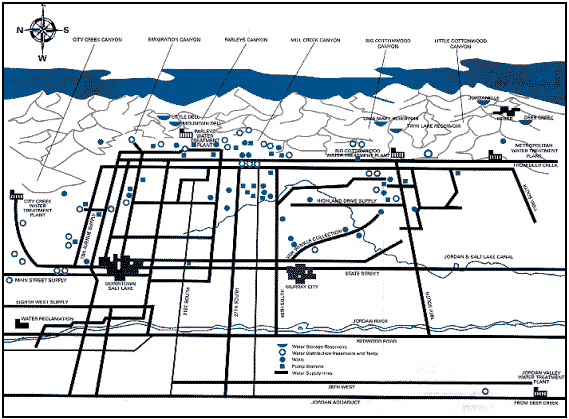
Where Do You Get Your Drinking Water?
About 57 percent of Salt Lake City's water supply comes from the canyons east of Salt Lake City--City Creek, Parleys, Big and Little Cottonwood. To supplement this base supply, about 15 percent comes from springs and is pumped from deep wells located along eastern Salt Lake County, tapping water from the aquifer beneath the valley. The remaining 27 percent comes from stored water in Deer Creek Reservoir in Provo Canyon. In the future, water supplied from the Central Utah Project Bonneville Units' Jordanelle Reservoir will provide water to meet projected population growth through the year 2025.
Currently, customers in the Salt Lake City/County service area use about 100,000-acre feet of water per year. (An acre-foot will cover a football field with one foot of water and provide water for a family of five for one year). The department serves a resident population of over 300,000 in Salt Lake City and eastern Salt Lake County and a daytime population of 400,000.
How Were The Water Resources Developed?
When Mormon pioneers settled the Salt Lake valley in 1847, the leaders established water practices to meet the needs of this valley that annually receives less than 16 inches of precipitation. Water was diverted from the streams and channeled across for crops and domestic uses. The valley's first water supply was City Creek. Later water from Parleys, Big Cottonwood, Mill Creek and Little Cottonwood Creeks was acquired through exchange agreements with farmers.
In 1935 the Metropolitan Water District of Salt Lake City was formed to sponsor the Provo River Project and the construction of Deer Creek Reservoir. Salt Lake City drilled deep wells to pump water from far beneath the Salt Lake valley.
In 1967, the Central Utah Water Conservancy District was formed to build the Central Utah Project and to capture part of the state's share of the Colorado River. This project provides water for the future. Salt Lake valley's citizens and leaders have supported water development that, if used wisely, will meet the city service area needs well into the next century.
How Is Drinking Water Protected From Contamination?
Salt Lake City Department of Public Utilities takes extraordinary measures to protect your drinking water from pollution. A primary element is watershed management, which helps prevent harmful organisms and chemicals from polluting the water before it reaches the water treatment plants. We believe that the higher the purity of the water reaching the treatment process, the higher the quality of water we can provide our customers.
When using the canyon watersheds for recreation, please obey the regulations, and do your part in protecting the environment and the quality of your drinking water.
The Salt Lake City Department of Public Utilities' water meets or exceeds drinking water standards under the Safe Drinking Water Act passed by Congress.
Be Water Conservation Conscious
- Check your toilet for leaks. A leak in your toilet may be wasting more than 100 gallons of water a day. To check, put a little food coloring in your toilet tank. If, without flushing, the coloring begins to appear in the bowl, you have a leak. Adjust or replace the flush valve, or call a plumber.
- Stop using your toilet as an ashtray or wastebasket. Every time you flush you waste five to seven gallons of water.
- Use your automatic dishwasher only for full loads. Every time you run your dishwasher, you use about 25 gallons of water.
- Take shorter showers and install water saving shower heads or flow restrictors. Long showers waste five to 10 gallons of water every minute.
- Turn off the water after you wet your toothbrush.
- Rinse your razor in the sink. Partially fill your sink with a few inches of warm water to rinse your blade.
- Plant drought-resistant trees and plants.
- Put a layer of mulch around trees and plants,
- Water your lawn only when it needs it.
- Don't run the hose while washing your car. Soap down your car, then use a hose just to rinse it off.
Call us at 483-6864 if you have any questions about your drinking water or the service you receive.
Prepared by the Salt Lake City Department of Public Utilities
1530 South West Temple, Salt Lake City, Utah 84115
